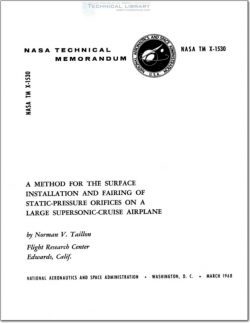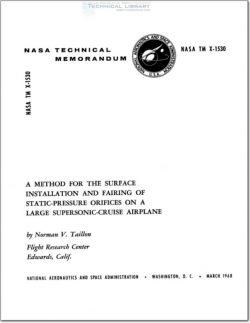NASA-TM-X-1530

- Version
- 201 Downloads
- 1.64 MB File Size
- 1 File Count
- June 15, 2016 Create Date
- June 15, 2016 Last Updated
A Method for the Surface Installation and Fairing of Static-Pressure Orifices on Large Supersonic Cruise Airplane

Flush static-pressure orifices in the surface of flight test and research airplanes
have, for many years, proved to be highly useful in the evaluation of flow character—
istics for further application toward skin—friction, boundary—layer—transition, and
pressure-distribution studies. The advent of supersonic—cruise airplanes and vertical
or short takeoff configurations with variable-geometry wings, inlets, and ejectors,
makes the use of static-pressure orifices an even more valuable tool for analysis of
the complex local flows encountered. The large—scale use of honeycomb-sandwich skin
and wide dispersion of integral fuel tanks throughout advanced aircraft, however, im—
pose severe restrictions against penetration of the skin for pressure orifices because
of the difficulties encountered in sealing and restoration. Similarly, the density of
systems hardware and airframe structure, if not the fundamental problem of access,
may well discourage internal routing of tubing, particularly when retrofitted to an
operational airplane.
Several possible techniques for the installation of flush orifices on the upper wing
surface of the XB—70 research airplane were considered. The method selected is de—
scribed in this paper. This method specifies installing orifices and tubing on the wing
surface and fairing them in to minimize the aerodynamic effect on the measured pres—
sures. The method requires no penetration of the skin, allows nearly unlimited se-
lection for the location and spacing of orifice rows, and permits complete removal of
the system without extensive disassembly, thereby facilitating a return to the pro—
duction configuration. Any convenient access to an instrumentation compartment may
be utilized.
The fairing material may also be used to smooth out surface irregularities such as
thermal expansion joints or welding beads.
Originally, the third experimental XB—70 airplane was to be fully instrumented
during final assembly for NASA skin—friction flight research. Succeeding events, how—
ever, led to transfer of the research program to the number 1 airplane (fig. 1) and to
retrofit of the instrumentation after initial flight tests had been completed.
| File | Action |
|---|---|
| NASA-TM-X-1530 A Method for the Surface Installation and Fairing of Static-Pressure Orifices on Large Supersonic Cruise Airplane.pdf | Download |

Comment On This Post